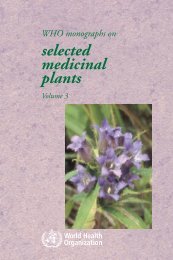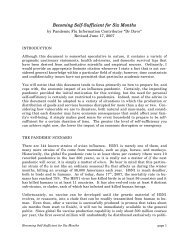You also want an ePaper? Increase the reach of your titles
YUMPU automatically turns print PDFs into web optimized ePapers that Google loves.
PURPLE OR PURPLE-BROWN SPORE PRINT<br />
almost always begun to turn pink by the time the veil has broken,<br />
and this gill color, combined with the ring on the stem and the<br />
free gills, makes the identification of it as a species of Agaricus<br />
almost foolproof. The cap is from 2 to 5 inches wide, the stem<br />
1/2 to i inch thick and 2 to 5 inches* long, usually rather short<br />
and squat. The flesh has an excellent flavor and is fairly tender,<br />
although some of the other species of Agaricus are considered<br />
better for eating.<br />
Eminently edible: AGARICUS RODMANI (Rodman's<br />
Mushroom)<br />
This mushroom (Figure 46) resembles Agaricus campestris,<br />
differing from it chiefly in its short, thick stem, its thick flesh and<br />
narrow gills, and the wide or double ring on the stem. The width<br />
of the gills scarcely exceeds one third the thickness of the flesh<br />
of the cap, a characteristic peculiar to this species. Also the wide<br />
or double ring is located below the middle of the stem; no other<br />
species of Agaricus has such a low waistline!<br />
As in A. campestris, the gills do not touch the stem, and the color<br />
of the gills changes from white in very young plants to pink, and<br />
then to a dark purple-brown.<br />
The cap normally expands while still an inch or two beneath<br />
the surface of the soil and is lifted up as the stem elongates, carrying<br />
a clump of earth above it. In size this mushroom resembles<br />
the preceding species, and as far as edibility is concerned the two<br />
could be considered identical. It is a common occupant of cities,<br />
and is found growing on lawns and along the grassy borders of<br />
streets.<br />
GENUS Hypholoma<br />
This genus has (i) violet to dark purple-brown spores, (2) a<br />
thin veil that breaks at the stem, leaving short-lived fragments of<br />
it clinging to the expanding cap, and (3) gills attached to the<br />
stem.<br />
77
















